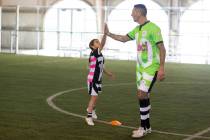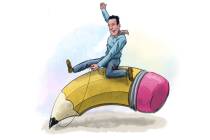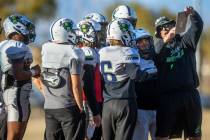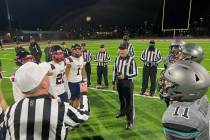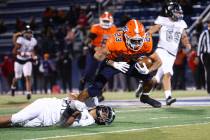Today’s roller girls skating into mainstream
It must have been two or three summers ago when I was first exposed to this latest incarnation of roller derby -- downtown, on Fremont Street, of all places. There were women, mostly young, a lot looking like the pugnacious musician Joan Jett, skating on a "flat track" consisting of nothing more than strips of blue masking tape -- the kind used to protect the walls when you are painting the baseboards -- arranged in a shape approximating that of an oval. This was in front of the stage where washed-up bands such as The Grass Roots and Steppenwolf perform free concerts.
These women skated the way Bambi walked on ice. Legs going in every direction. Only the legs of the roller derby players were encased in fishnet stockings. They wore tiny, tiny skirts. Many sported body piercings. Many more sported tattoos.
They skated under alter egos based on deviant acts of mayhem, both sexual and physical: Ivanna S. Pankin, Ace Bondage, Alexis of Evil, Wham Bam Shank You Ma'am, Violet Moodswings, Suzy Homewrecker, Wolf Blitzher, Whip Me Houston, Zsa Zsa More Gore.
The teams, I recall, were called the "T's" and "A's." Lots of men, for some reason, had gathered to watch.
And yet, I remember thinking, this will never catch on.
The next day I wrote something to the effect that this wasn't your old man's roller derby. It was more like Billy Idol's roller derby.
I was wrong. This new breed of roller girls is no longer dancing with, or by, itself.
In 2001, there was one flat-track roller derby league. Now, according to the Women's Flat Track Derby Association, there are 470, representing 41 states and Canadian provinces (including the Fabulous Sin City Rollergirls of Las Vegas, comprising four teams of wannabe Kansas City Bombers.)
Flat-track roller derby, once the domain of iconoclasts and nonconformists, is going mainstream, having spawned a full-length movie ("Whip It," starring Drew Barrymore) a reality series ("Roller Girls" on the A&E Network) and a convention of sorts, called RollerCon, held last weekend at the Sport Center of Las Vegas.
Based on the roller girls I spoke to, flat track is sort of like Kate Gosselin or Kevin Federline or the Eiffel Tower, which, like Federline, once was thought of as an eyesore --- somehow it became popular, although nobody can quite pinpoint why.
"It's like a secluded island of misfit toys ... with an aggression problem," said Emerald City, Seattle, delegate Grace Sears (roller girl name: LivThruDis), lowering her shorts and lifting her top ("Whoa, roller girl, cut off the jam!") to reveal a sunset-colored bruise roughly the shape and size of Africa.
For Tammi Chaddock (roller girl name: Fun2PlayWith) of Porterville, Calif., it's an outlet for a 41-year-old grandmother to recapture youth and regenerate muscle. "I do takedowns," she says of her position as a pivot/blocker for the SinCal Derby Vixens and her soon-to-be job in the mental ward of a State of California hospital.
Chaddock's team skates in the parking lot of an abandoned warehouse on the outskirts of Bakersfield, Calif., where, she says, she has yet to encounter the Riddler and his henchmen plotting a diabolical takeover of Gotham City. But it's proof you can choose up sides and play almost anywhere, which might explain why flat track is blooming, and traditional, banked-tracked roller derby is withering away in TV archives.
Another difference between flat track, according to recently engaged Jillian Pearse (roller girl name: Cee Cee Sickness) of Edmonton, Alberta, and the TV archetype ("If you're still available, Randi Whitman, call me") is that when you see Pearse flying through the infield on her keister, it's not theatrically enhanced. Those are real knees and real elbows, taking divots out of real shins and real ribs. The scoring is legit, not contrived.
Pearse, who had just finished getting kneed and elbowed up and down Fremont Street, toward where that Carl Ferris guy plays the saxophone, watched with me as a referee removed the masking tape "track" with one hand while holding a giant 24-ounce can of Modelo beer in the other.
"That's why I left my ring at home," she said.
"You mean the beer and the parties?" I said.
No, she said. The knees and the elbows.
"I didn't want to break it."
Pearse, 28, said this was her second RollerCon, but after coming to last year's to learn, she planned this year to play.
And yet, when I poked my head into a seminar the next day during which a Wrigley Field beer vendor calling herself Val Capone and Jerry Setzer, son of Leo Setzer, the original old school roller derby promoter, were telling a captive audience of roller girls that if they lose the fishnets and the deviant monikers and maybe a third of the tattoos, the best of their lot could evolve into family-oriented sport worthy of a television contract, there was Pearse, front-row center, scribbling furiously in the margins of her notebook.
Billy Idol, as far as I could tell, had left the building.
Las Vegas Review-Journal columnist Ron Kantowski can be reached at rkantowski@reviewjournal.com or 702-383-0352.










